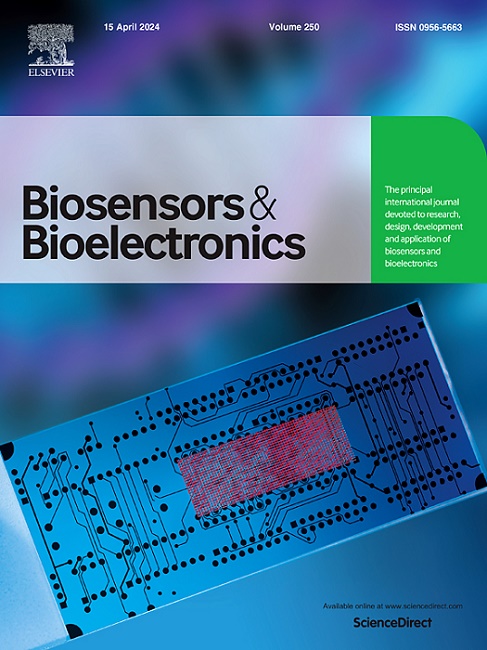Two-dimensional photonic crystal acetylcholinesterase hydrogel and organohydrogel sensors for efficient detection of organophosphorus compounds
IF 10.7
1区 生物学
Q1 BIOPHYSICS
引用次数: 0
Abstract
Sensors capable of detecting organophosphorus (OP) compounds have attracted the most attention owing to severe OP contamination worldwide. Despite many years of research, the developed OP sensors mainly focused on detecting water-soluble OPs in proper environments and the exploration of OP sensors suitable in resource-limited areas is extremely challenging. Here, a simple two-dimensional photonic crystal (2D PC) hydrogel featuring capabilities of effectively quantitative determination of OP compounds is facilely constructed by immobilizing the enzyme acetylcholinesterase (AChE) onto a bovine serum albumin (BSA) protein hydrogel. Owing to the specific interaction between AChE and OP compounds, the OP compounds are easily bound to the hydrogel, triggering volume phase transition and resulting in apparent Debye diffraction ring variations. The resulting hydrogel sensors show a limit of detection (LoD) of 2.23 nM for trichlorfon and 0.07 nM for diethyl methylphosphonate (DMPP), respectively. On the basis of the hydrogel, a responsive organohydrogel is facilely fabricated utilizing a solvent exchange strategy to meet the requirements of applications in harsh environments and detection of the non-water-soluble OP compounds. The organohydrogel sensors, however, demonstrated a LoD of 0.70 μM for trichlorfon and 4.46 μM for DMPP, respectively. This work provides new light on the development of next-generation stable, low-cost, and portable field sensing devices.
用于高效检测有机磷化合物的二维光子晶体乙酰胆碱酯酶水凝胶和有机水凝胶传感器
由于全球有机磷(OP)污染严重,能够检测有机磷(OP)化合物的传感器最受关注。尽管经过多年的研究,但已开发的 OP 传感器主要集中于检测适当环境中的水溶性 OP,而探索适合资源有限地区的 OP 传感器极具挑战性。本文通过将乙酰胆碱酯酶(AChE)固定在牛血清白蛋白(BSA)蛋白水凝胶上,方便地构建了一种简单的二维光子晶体(2D PC)水凝胶,具有有效定量检测 OP 化合物的功能。由于乙酰胆碱酯酶与 OP 化合物之间的特殊相互作用,OP 化合物很容易与水凝胶结合,从而引发体积相变,导致明显的德拜衍射环变化。所制成的水凝胶传感器对敌百虫的检测限(LoD)为 2.23 nM,对甲基膦酸二乙酯(DMPP)的检测限(LoD)为 0.07 nM。在水凝胶的基础上,利用溶剂交换策略方便地制备了一种响应性有机水凝胶,以满足在恶劣环境中应用和检测非水溶性 OP 化合物的要求。然而,有机水凝胶传感器对敌百虫的 LoD 值为 0.70 μM,对 DMPP 的 LoD 值为 4.46 μM。这项工作为开发下一代稳定、低成本和便携式现场传感装置提供了新的思路。
本文章由计算机程序翻译,如有差异,请以英文原文为准。
求助全文
约1分钟内获得全文
求助全文
来源期刊

Biosensors and Bioelectronics
工程技术-电化学
CiteScore
20.80
自引率
7.10%
发文量
1006
审稿时长
29 days
期刊介绍:
Biosensors & Bioelectronics, along with its open access companion journal Biosensors & Bioelectronics: X, is the leading international publication in the field of biosensors and bioelectronics. It covers research, design, development, and application of biosensors, which are analytical devices incorporating biological materials with physicochemical transducers. These devices, including sensors, DNA chips, electronic noses, and lab-on-a-chip, produce digital signals proportional to specific analytes. Examples include immunosensors and enzyme-based biosensors, applied in various fields such as medicine, environmental monitoring, and food industry. The journal also focuses on molecular and supramolecular structures for enhancing device performance.
 求助内容:
求助内容: 应助结果提醒方式:
应助结果提醒方式:


